I learned to knit as a kid, when I was 10, oddly enough, from a babysitter. That was odd because my mom is a knitter, my grandma was a knitter, and my aunt was a knitter. They were constantly sewing, knitting, and crocheting around me, and I was always helping myself to their cast-off scraps and asking for stitching instructions. But I loved this babysitter. She was there every Sunday that my mom and stepdad went to the Kansas City Chiefs football game. She was a college student and very cool. One Sunday she brought her own knitting and decided to teach me. I wanted to be as cool as she was, so, of course, I learned to knit that day.
When I started knitting, I fell deeply in love. I garter stitched for a little bit, but I wanted to fly! Mom took me to the craft store. I chose a pattern for a pointed front vest with cables starting on the points and lavender acrylic yarn. (yikes) But I made it! I don’t think I ever sewed it together or wore it. That wasn’t the point for me. The glory was in the knitting and the challenge of twisting the yarn to create this amazing shape.
My mom had a dream to own her own yarn shop. When I was about 13, she was able to start her yarn shop in the corner of a needlepoint shop. She quickly outgrew that and moved to her own space. I helped her, but it was a lot for a single mom of two. She sold the shop a few years later. By then I was constantly knitting and had a very respectable stash!
I eventually went to college at the Kansas City Art Institute studying in their Fiber Department. I spent my junior year at Brighton Polytechnic in England. Their fashion textiles program included knitting and was specifically for fashion designers. Because it was so close to London, we worked with several commercial fashion businesses from that area. I knew then that this was my world, these were my people. One of my fellow students learning about machine knitting was Kim Hargreaves, who was already working for Rowan.
After graduating college, I worked for about four years for a Kansas City clothing boutique, Asiatica. No knitting was involved there, but I learned quite a bit about fitting clothes on a variety of sizes and worked with beautiful fabrics from Japan and Italy.
In 1994, I received a call from the owner of Peruvian Connection. She was looking for an artist/designer to manage the small design department of her mostly knitwear company. I leapt at the opportunity. My first day was July 10, 1994. We met at the airport and flew to Peru. In 2001, I was able to leave all the management work and design full time. I have worked with many talented knitters in South America. I design mostly fine-gauge knit jacquards, but I also design handknit, handloomed, and crochet pieces. I have worked with Kaffe Fassett and Brandon Mably for years on their designs for Peruvian Connection.
When Jillian Moreno initially mentioned to me that PLY Magazine would have a sweater issue, I was excited to apply. The idea of a “stash sweater” was presented and I was in! To be honest, my idea of stash mixing was in the fiber stage. All my design ideas were based on a single very mixed color yarn. Imagine my surprise when I received various yarns in a mix of different colors, mimicking stash yarn rather than fiber. So I told myself, “I’ve been a knitwear designer for thirty years. I’m going to make this work!”
Four spinners were each given differing braids and spinning guidelines. The dyer, Essential Fibers, offered to send me a fifth accent color as well as an additional skein of the background color. I took them up on the offer. I initially spun the additional fiber as singles, thinking I might want to mix the plies to blend colors together. I later plied them together, so all the yarns are 2-ply.
I soon realized a big challenge of this design was that I not only needed to use all these colors, but I was going to need to use them in equal amounts to have enough for a sweater.
In my first swatch, I tried out the idea of mixing the 2-ply handspun yarns with the singles yarn I spun. I liked the idea – but I wanted more interesting texture. I also thought the randomness would be hard for others to recreate with their own stash, so not a great idea for the PLY article.
Then I saw this amazing sweater from Ulla Johnson and thought I would try a striped dropped stitch with the yarns.
This was more interesting to me – but I felt that using all 2-ply yarns would be more accessible for most of us.
Swatching and playing with the yarns helped me to narrow down what I thought would be helpful for spinners choosing yarns from spun stash. Most of us have a default spin giving us consistent handspun yarns. I wanted a stitch that had texture and would blend these colors together in a pleasing way. So I sat in front of my knitting library and went through my knitting stitch books.
I knew I would need all or most of the yarn I had for the sweater and needed to use the yarns in equal amounts. I had two braids of the light green, Zombie, so that could serve as a base color. I loved the idea of blending rows of colors into one another like an Ikat effect. I found a stitch in The Harmony Guide to Knitting Stitches called Garter Slip stitch. The stitch has several variations. I knit a swatch using all five colors of yarn. I loved the texture, the way the rows blended together, and the way cycling the odd number of colors through the stitch gave me a complex looking pattern but was actually very simple to knit.
Once I figured out my plan for the fabric of the sweater, the rest was easy. I wanted a cardigan because I am constantly taking my sweaters off and putting them on due to hormonal temperature fluctuations (if you know what I mean). Knitting in one piece as much as possible was important for a couple of reasons. First, most of us are not the biggest fans of sweater assembly. Second, keeping the stripe continuity was important. I would have loved to pick up and knit the sleeves down from the body in one piece, but the stitches and the color pattern would be upside down. The rest of the details are classic sweater details that I love. Two-by-two rib is my default. I love how it looks! Splitting the ribbing at the sides is a favorite. I am not a fan of tight ribbing. The two-button closure for a swinging hem is also a detail I use frequently. Lastly, no floppy cuffs!
Here are progress photos:
After finishing the sweater design, I wanted to play with color variations to the Slip Garter stitch. Using commercial yarn, I knit swatches using only one color as well as variations on two, three, four, and five colors.
I plan to knit the Stash Sweater using yarns from my own handspun stash! I dug through my handspun and did some playing with color combinations
I very much want this to be a useful pattern for handspinners. I am excited and hopeful to see many combinations from our spinning community!
Tabbetha McCale Evans, a Kansas City native, has knit and crafted since she was a child influenced by the women in her family. Her love of spinning started in 1999. Tabbetha has been designing textiles, clothing and jewelry for Peruvian Connection for the past twenty-nine years.







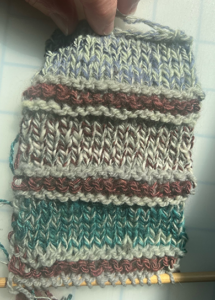

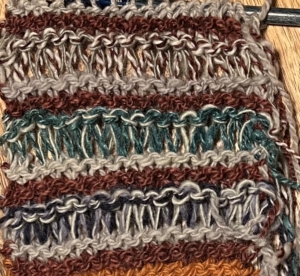

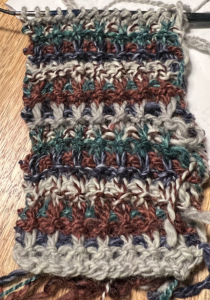






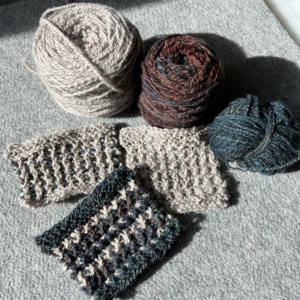

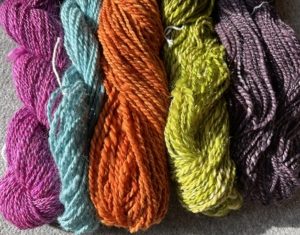






Leave a Reply
Want to join the discussion?Feel free to contribute!